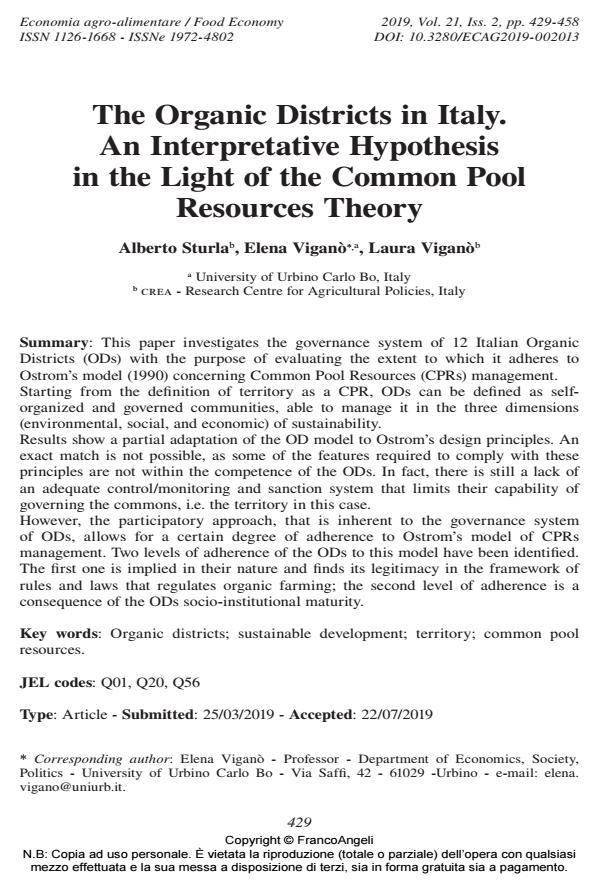The Organic Districts in Italy. An Interpretative Hypothesis in the Light of the Common Pool Resources Theory
Titolo Rivista ECONOMIA AGRO-ALIMENTARE
Autori/Curatori Alberto Sturla , Elena Viganò, Laura Viganò
Anno di pubblicazione 2019 Fascicolo 2019/2
Lingua Inglese Numero pagine 30 P. 429-458 Dimensione file 196 KB
DOI 10.3280/ECAG2019-002013
Il DOI è il codice a barre della proprietà intellettuale: per saperne di più
clicca qui
Qui sotto puoi vedere in anteprima la prima pagina di questo articolo.
Se questo articolo ti interessa, lo puoi acquistare (e scaricare in formato pdf) seguendo le facili indicazioni per acquistare il download credit. Acquista Download Credits per scaricare questo Articolo in formato PDF

FrancoAngeli è membro della Publishers International Linking Association, Inc (PILA)associazione indipendente e non profit per facilitare (attraverso i servizi tecnologici implementati da CrossRef.org) l’accesso degli studiosi ai contenuti digitali nelle pubblicazioni professionali e scientifiche
This paper investigates the governance system of 12 Italian Organic Districts (ODs) with the purpose of evaluating the extent to which it adheres to Ostrom’s model (1990) concerning Common Pool Resources (CPRs) management. Starting from the definition of territory as a CPR, ODs can be defined as selforganized and governed communities, able to manage it in the three dimensions (environmental, social, and economic) of sustainability. Results show a partial adaptation of the OD model to Ostrom’s design principles. An exact match is not possible, as some of the features required to comply with these principles are not within the competence of the ODs. In fact, there is still a lack of an adequate control/monitoring and sanction system that limits their capability of governing the commons, i.e. the territory in this case. However, the participatory approach, that is inherent to the governance system of ODs, allows for a certain degree of adherence to Ostrom’s model of CPRs management. Two levels of adherence of the ODs to this model have been identified. The first one is implied in their nature and finds its legitimacy in the framework of rules and laws that regulates organic farming; the second level of adherence is a consequence of the ODs socio-institutional maturity.
Parole chiave:Organic districts; sustainable development; territory; common pool resources.
Jel codes:Q01, Q20, Q56
- Neo-Endogenous Rural Development in Favor of Organic Farming: Two Case Studies from Italian Fragile Areas Angelo Belliggiano, Alberto Sturla, Marco Vassallo, Laura Viganò, in European Countryside /2020 pp.1
DOI: 10.2478/euco-2020-0001 - Potential outcomes and impacts of organic group certification in Italy: An evaluative case study Francesco Solfanelli, Emel Ozturk, Patrizia Pugliese, Raffaele Zanoli, in Ecological Economics 107107/2021 pp.107107
DOI: 10.1016/j.ecolecon.2021.107107 - Comparing social sustainability assessment indicators and tools for bio-districts: building an analytical framework Giacomo Packer, Cesare Zanasi, in Frontiers in Sustainable Food Systems 1229505/2023
DOI: 10.3389/fsufs.2023.1229505 - Organic Farming Systems and Rural Revitalization in Italy—Current Situation and Way Forward Zollet Simona, in Journal of Rural Problems /2024 pp.27
DOI: 10.7310/arfe.60.27 - Factors fostering and hindering farmers' intention to adopt organic agriculture in the Pesaro-Urbino province (Italy) Maurizio Canavari, Federico Gori, Selene Righi, Elena Viganò, in AIMS Agriculture and Food /2022 pp.108
DOI: 10.3934/agrfood.2022008
Alberto Sturla , Elena Viganò, Laura Viganò, The Organic Districts in Italy. An Interpretative Hypothesis in the Light of the Common Pool Resources Theory in "ECONOMIA AGRO-ALIMENTARE" 2/2019, pp 429-458, DOI: 10.3280/ECAG2019-002013